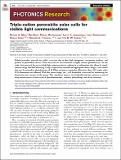Files in this item
Triple-cation perovskite solar cells for visible light communications
Item metadata
| dc.contributor.author | Mica, Natalie | |
| dc.contributor.author | Bian, Rui | |
| dc.contributor.author | Manousiadis, Pavlos | |
| dc.contributor.author | Krishnan Jagadamma, Lethy | |
| dc.contributor.author | Tavakklolnia, Imam | |
| dc.contributor.author | Haas, Harald | |
| dc.contributor.author | Turnbull, Graham | |
| dc.contributor.author | Samuel, Ifor David William | |
| dc.date.accessioned | 2020-07-23T14:30:09Z | |
| dc.date.available | 2020-07-23T14:30:09Z | |
| dc.date.issued | 2020-08-01 | |
| dc.identifier | 268444503 | |
| dc.identifier | 1e1fca60-c608-4d04-b284-01428cd9fab4 | |
| dc.identifier | 000556951400001 | |
| dc.identifier | 85090980281 | |
| dc.identifier.citation | Mica , N , Bian , R , Manousiadis , P , Krishnan Jagadamma , L , Tavakklolnia , I , Haas , H , Turnbull , G & Samuel , I D W 2020 , ' Triple-cation perovskite solar cells for visible light communications ' , Photonics Research , vol. 8 , no. 8 , pp. A16-A24 . https://doi.org/10.1364/PRJ.393647 | en |
| dc.identifier.issn | 2327-9125 | |
| dc.identifier.other | ORCID: /0000-0001-8678-9126/work/77893748 | |
| dc.identifier.other | ORCID: /0000-0002-4339-2484/work/77893788 | |
| dc.identifier.uri | https://hdl.handle.net/10023/20322 | |
| dc.description | Funding: UK EPSRC under grant codes EP/L015110/1 and EP/L017008/1. Dr. L. K. Jagadamma acknowledges support from a Marie Skłodowska-Curie Individual Fellowship (European Commission) (MCIF: No. 745776). Harald Haas acknowledges financial support from the Wolfson Foundation and Royal Society. He also acknowledges financial support by the Engineering and Physical Sciences Research Council (EPSRC) under an Established Career Fellowship grant EP/R007101/1. | en |
| dc.description.abstract | Hybrid perovskite materials are widely researched due to their high absorptivity, inexpensive synthesis, and promise in photovoltaic devices. These materials are also of interest as highly sensitive photodetectors. In this study, their potential for use in visible light communication is explored in a configuration that allows for simultaneous energy and data harvesting. Using a triple-cation material and appropriate device design, a new record data rate for perovskite photodetectors of 56 Mbps and power conversion efficiencies above 20% under white LED illumination are achieved. With this device design, the −3 dB bandwidth is increased by minimizing the dominating time constant of the system. This correlation between the bandwidth and time constant is proved using measurements of time-resolved photoluminescence, transient photovoltage, and device resistance. | |
| dc.format.extent | 9 | |
| dc.format.extent | 1669802 | |
| dc.language.iso | eng | |
| dc.relation.ispartof | Photonics Research | en |
| dc.subject | QC Physics | en |
| dc.subject | TK Electrical engineering. Electronics Nuclear engineering | en |
| dc.subject | DAS | en |
| dc.subject | SDG 7 - Affordable and Clean Energy | en |
| dc.subject.lcc | QC | en |
| dc.subject.lcc | TK | en |
| dc.title | Triple-cation perovskite solar cells for visible light communications | en |
| dc.type | Journal article | en |
| dc.contributor.sponsor | EPSRC | en |
| dc.contributor.sponsor | European Commission | en |
| dc.contributor.institution | University of St Andrews. School of Physics and Astronomy | en |
| dc.contributor.institution | University of St Andrews. Centre for Biophotonics | en |
| dc.contributor.institution | University of St Andrews. Condensed Matter Physics | en |
| dc.contributor.institution | University of St Andrews. Sir James Mackenzie Institute for Early Diagnosis | en |
| dc.identifier.doi | 10.1364/PRJ.393647 | |
| dc.description.status | Peer reviewed | en |
| dc.identifier.grantnumber | ep/l017008/1 | en |
| dc.identifier.grantnumber | 745776 | en |
This item appears in the following Collection(s)
Items in the St Andrews Research Repository are protected by copyright, with all rights reserved, unless otherwise indicated.

